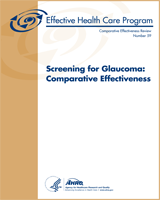NCBI Bookshelf. A service of the National Library of Medicine, National Institutes of Health.
Ervin AM, Boland MV, Myrowitz EH, et al. Screening for Glaucoma: Comparative Effectiveness [Internet]. Rockville (MD): Agency for Healthcare Research and Quality (US); 2012 Apr. (Comparative Effectiveness Reviews, No. 59.)
This publication is provided for historical reference only and the information may be out of date.
Given the ongoing lack of evidence regarding screening for open-angle glaucoma (OAG), there is a clear need for appropriate research to fill the multiple gaps that exist. It has repeatedly been suggested that a standard for diagnosis be adopted to allow for synthesis of evidence and comparison of outcomes across studies. Glaucoma professional societies would be well suited to help address this issue and should be encouraged to do so, since it fundamentally limits research in a number of areas, including screening. Some of the important questions are outlined below using the standard Population-Intervention-Comparison-Outcomes format.
Does Screening for Glaucoma Alter Either Intermediate or Final Outcomes?
Population:
- People at risk of glaucoma
- Age
- Race
Intervention:
- Randomization to one or more screening tests for glaucoma
- Appropriate followup or treatment based on screening outcome
Outcome:
- Measurements of intermediate outcomes
- Visual field.
- Optic nerve damage
- Measurement of final outcomes
- Visual impairment
- Patient reported outcomes
What Tests or Devices are Best Able To Identify People With Glaucoma in a Screening Setting?
Population:
- People with glaucoma of various stages, determined using standard criteria
- People without glaucoma, matched to the glaucoma group
Intervention:
- Multiple candidate glaucoma screening tests applied to both groups
Outcome:
- Measures of diagnostic accuracy (sensitivity, specificity, area under the ROC curve) for each device
- Assessment of the comparative effectiveness of devices
Are There Groups in Which Screening Might be More Effective?
Population:
- People at varying degrees of glaucoma risk based on population studies
Intervention:
- One or more glaucoma screening programs or tests
- Definitive diagnosis based on standard definition of disease
Outcome:
- The comparative effectiveness of various tests or programs in terms of identifying glaucoma
Are There Stages of Disease at Which Screening is More Appropriate?
Population:
- People with glaucoma of various stages, determined using standard criteria
- People without glaucoma, matched to the glaucoma group
Intervention:
- One or more glaucoma screening programs or tests
- Definitive diagnosis based on standard definition of disease
Outcome:
- Assessment of the relative benefit of screening for various stages of glaucoma
- Future Research Needs - Screening for Glaucoma: Comparative EffectivenessFuture Research Needs - Screening for Glaucoma: Comparative Effectiveness
- ursolic acid (79)GEO DataSets
Your browsing activity is empty.
Activity recording is turned off.
See more...
